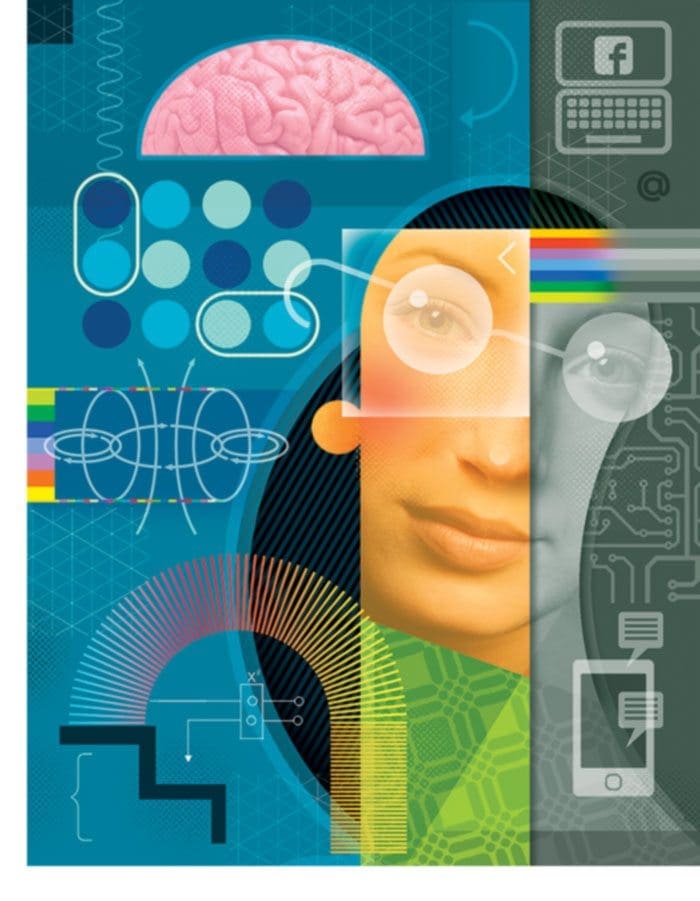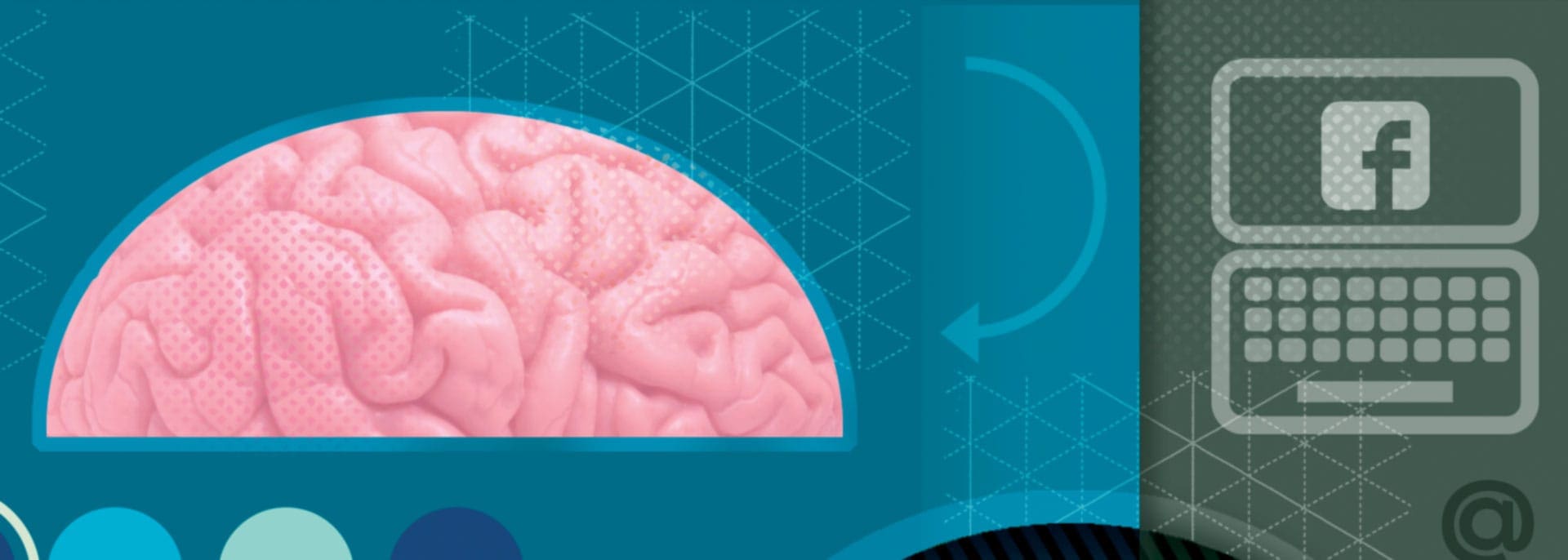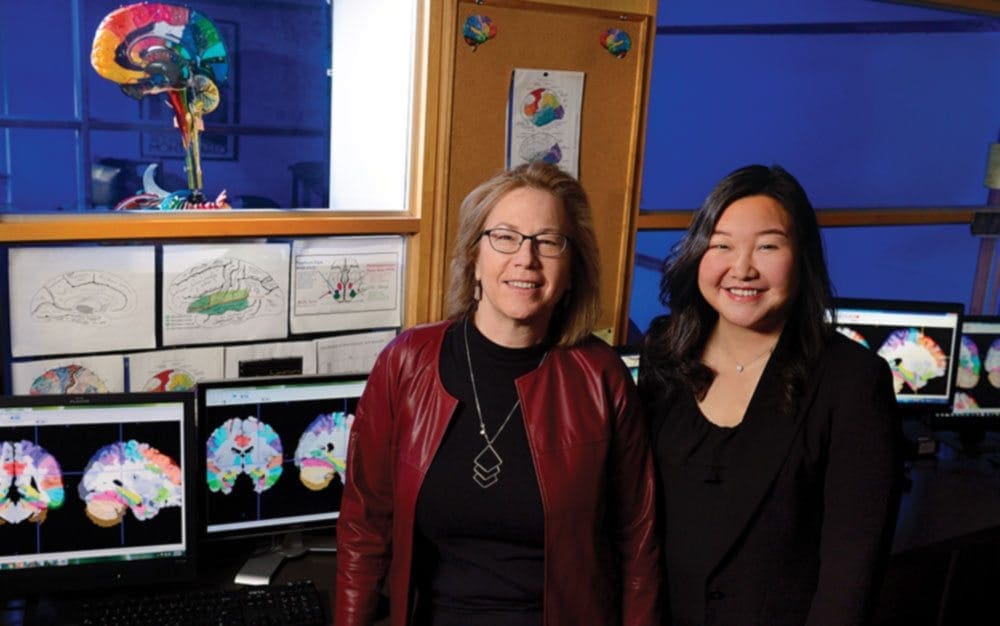
Her twice-a-week lectures were packed. Neuroscience remains one of the most popular majors at the Krieger School of Arts and Sciences. But her course’s traditionally glowing reviews were gradually eroding, and her students were becoming increasingly disengaged. This, despite Rapp’s energy, enthusiasm, and conviction that the study of how the brain makes sense of the world “was the most exciting thing you could possibly ever hear about.”
She decided that drastic action was called for. So she reinvented the course, putting her lectures online and using class time training small groups of students to navigate the functional geography of the brain with software on their laptops. Grades rose and the number of students AWOL on social media plummeted. She was delighted.
Rapp is just one of a growing number of Johns Hopkins professors who are adopting innovative teaching methods and technology. Their aim is to both improve instruction and adapt to a generation raised in a wired world.
Professors are always testing new teaching techniques, and the incentives to explore the pedagogical frontier are increasing. Johns Hopkins University President Ronald J. Daniels launched the Gateway Sciences Initiative in 2011 to reinvigorate the teaching of introductory science and engineering courses, with the aim of making them “gateways” to study in these fields—rather than hurdles for students to clear.
Technological and cultural changes are also driving classroom innovation. Online video and instructional software has reduced the amount of time professors must spend introducing material, freeing them to coach students on how to apply what they’re learning. Students are free to watch the lectures on their own schedules, and to focus on concepts that they find the most difficult to master.
Flipping the Classroom
The turning point for Brenda Rapp came at an annual meeting of psychologists in 2015, when she heard a researcher at the University of California, Davis, explain how he had redesigned his introductory cognitive psychology course based on the results of studies in his field of learning and memory. These included keeping students active, not overloading them with new material, and frequently prompting them to remember what they had learned.
Rapp was impressed and decided to rebuild her course from the ground up. In today’s pedagogical jargon, she decided to “flip” her classroom, meaning students would watch lectures online outside of class hours, then review and apply lecture material during them.
Professor Brenda Rapp (left) and Assistant Professor Soojin Park use interactive computer programs that better enable students to learn how the brain functions.
She wasted little time. In a meeting at Johns Hopkins’ Center for Educational Resources in October 2015, she outlined her plans and told staffers she wanted to launch her revamped CogSci course in the spring. Center director Michael Reese asked if she meant the spring of 2017. “She said, ‘No, I want to do it for this coming spring,'” he recalls.
Rapp and her colleague Soojin Park, an assistant professor in the Department of Cognitive Science, set to work with Reese and his colleague, Brian Cole, preparing the online videos and classroom materials they would need. “The Center for Educational Resources was essential to the success of the project,” says Rapp.
Rapp and Park rewrote and videotaped the 20 lectures they deliver each semester, dividing them into three easily digestible sections, and wrote quizzes for students to take at the end of each. That was the easy part, Rapp says. The hard part was dreaming up classroom exercises to engage and challenge her students.
So she and Park developed a series of lessons where students learn how the brain functions by using computer programs that allow them to explore its intricate structure in three dimensions. The approach, called “active learning,” is a popular strategy for the new student-focused classroom.
In one of the new classroom sessions, students are asked to predict how the pattern of lesions produced by a stroke would likely affect a patient’s language skills. In others, students stage a mock courtroom debate on the merits of using neuroimaging technology as a lie detector, or test the so-called “attentional blink,” the tendency of the brain to fail to register events that occur in rapid succession. For their final project, the students work in a team to put together a mock National Institutes of Health grant proposal. Each group must devise a way to answer a novel question about how the brain works.
Teaching the reimagined course is a labor-intensive enterprise. Rapp and Park lead a team of eight postdocs, graduate students, and undergraduate teaching assistants. All meet weekly to discuss and coordinate the exercises. Rapp says she hopes to find ways to teach the course more efficiently, but the results so far have been worth all the added human power and effort. “The value for the students is really amazingly more [than before],” she says.
Last year, one of Rapp’s students was summoned to the emergency room after his father had a stroke. The student downloaded the hospital’s MRI scans and traced the lesions in his father’s brain, and compared them to lesions that produced known symptoms in similar areas. While the experience was traumatic, Rapp says, the student felt he was contributing to his father’s care. “From a teaching point of view, that’s about as gratifying as it gets.”
She and Park have conducted student focus groups and surveys, reviewed course evaluations, and compared student performance before and after the switch. In the first year, overall grades in the course rose by about 5 percent. More telling: Rapp says that engagement during active learning sessions has averaged 95 percent.
Before the class was “flipped,” only six students out of more than 200 said that the best part of the course was their interaction with faculty members. That figure more than tripled in the first year, to 20.
Likewise, before the changes, only 13 students said the lectures were their favorite aspect of the course. After the first year of the revamped course, that number climbed to 67. Some students said they watched the videotaped lectures three or four times.
The Physics of Slinkys
Inspired by the university’s Gateway Sciences Initiative, Bob Leheny and his colleagues in the Department of Physics and Astronomy decided that their approach to teaching introductory physics had to change. But how? “We knew that out there in the landscape of research into physics education, there were more innovative approaches,” says Leheny, a professor in the department. “But we didn’t know what the right thing to do was.”
So they studied programs elsewhere and adapted elements of two models, one developed at North Carolina State University and the other at MIT. In practice, this meant replacing live lectures with online, animated software that introduces students to the concepts. And it required creating classrooms where up to 85 students could sit at tables, working in small groups to solve problems and perform simple experiments.
In Professor Robert Leheny’s class, students are asked to explain the physics of a particular experiment to one another as a way of understanding it more fully.
A typical class begins with the instructor reviewing the online material with students. Then students are given three 15-minute exercises, including what Leheny calls “tangibles”—hands-on activities or experiments that make hard-to-wrap-your-head-around, abstract physics concepts concrete.
In one tangible, students test the law of inertia, which says that an object moving through space will continue in a straight line at a constant speed unless acted on by some force. The concept sounds simple, but it can be difficult to grasp. So students spin a ball bearing inside an upside-down petri dish on their table and lift the dish. The bearing shoots out in a straight line. “Even though you’ve told them this would happen, it’s not what they envision until they really force themselves to see it,” Leheny says.
Students study oscillations in Slinkys and the concept of an object’s center of gravity using rulers and weights. They’re asked to describe the physics to one another, in plain language, because explaining something to someone else is a good way to understand it.
Such peer-to-peer instruction is also important, Leheny says, because students listen to each other more critically than they do a professor during a lecture. “They ask themselves, ‘Is this consistent with my own understanding?'”
In active learning sessions, he says, fewer students “fade into the background” because their teams rely on their contribution. “I think the level of engagement during class time is much higher than when I was teaching traditionally.”
The Department of Physics and Astronomy first offered the reengineered physics course four years ago. Starting in the fall of 2015, it expanded from one course each semester to two. Total enrollment has tripled, from 47 the first fall semester to 160 this past spring.
For the first three academic years, Leheny taught the course in the fall semester while his colleague, Professor Petar Maksimovic, a particle physicist, taught it in the spring. Starting in the fall of 2016, another section of the course was added, taught by Professor Rosemary Wyse, an astrophysicist, and Professor Daniel Reich, who conducts research in condensed matter physics.
Leheny says that the revised course has forced him to learn a new role in the classroom. In lecture courses, he enjoyed displaying his erudition and grasp of physics. He felt like a star player. Now he says he is more of a coach helping the students reach their peak performance.
“The element of performance in a lecture class is very appealing,” he says. “But the engagement with students is at a much deeper level in this class.”
Mysteries of the Museum
When Sanchita Balachandran was planning her Spring 2015 Recreating Ancient Greek Ceramics course, she decided that she wanted to do more than just have her undergraduate students read about and study ancient Greek kylikes, the exquisitely decorated wine cups that are among the most celebrated works of antiquity. As an expert in the conservation and technical study of art, she wanted her students to develop a deeper understanding of them.
So while Balachandran, associate director and conservator at the university’s Archaeological Museum, required the class to read about and study photographs of these fragile objects, she also had students handle some in the classroom—carefully, with supervision and wearing gloves.
Students in Sanchita Balachadran’s (center) class don’t just read about ancient Greek wine cups called kylikes—they recreate them.
Later they traveled to Baltimore Clayworks to help master potter Matthew Hyleck recreate the process of making the cups. Hyleck shaped the elegant bowls, and students painted them and built the kiln used to fire them. Classical scholars had assumed that the bowls had been made using the same techniques. What the class discovered, she says, was that the existing scholarship and scientific research on their production couldn’t explain all the variations they saw in the cups.
Not only were her students engrossed in their work, says Balachandran, it’s remarkable “to see how closely tied up this group of undergraduates still is with this project.” Some still stay in touch through the museum’s Facebook page, she says, and three have sought out collections of kylikes on their travels and sent Balachandran photos of their favorites.
Over the past two years, she says, she has tried to build courses around similar projects in which students, while mastering the scholarship and history of ancient artifacts, can make their own discoveries.
In the fall of 2015, Balachandran and 11 of her students participated in the Ancient Panel Paintings: Examination, Analysis, and Research project, an effort to learn more about the hundreds of mummy portraits discovered since the beginning of the 18th century in excavations of tombs in Egypt. These images, painted on wood panels, were found in the funeral wrappings of the deceased, and were sought by collectors.
Little is known about the artists who painted the images or the people they represent. After the portraits were excavated and sold to collectors, records of their burials were lost. And they are rare. Only about a thousand survive, scattered in collections all over the world.
The aim of the project, led by the Getty Museum in Los Angeles, was to gather as much technical detail as possible on each painting. Researchers are seeking to identify the styles of individual artists or discover physical clues that could shed light on the paintings’ provenances, their subjects, and their histories.
Before the students in her class launched into an intense technical study of two of the portraits, none of them had ever heard of mummy portraits. Over the course of the semester, she says, many of them grew fascinated with the people depicted on the panels. “They became very invested in who these people were,” she says. Last spring, Balachandran was invited to present the results of the research at a meeting at the British Museum, which participated in the project.
She is currently leading a team including undergraduates in a multidisciplinary study of two ancient Egyptian mummies, one owned by Hopkins and another shared with Goucher College but on long-term loan to Hopkins. The aim is to better date and describe the remains, and to use modern imaging technology to recreate their long-forgotten faces.
Balachandran says she personally finds teaching-as-discovery at least as inspiring as her students do. “Once they realize I don’t know all the answers, it’s a really exhilarating, exciting environment,” she says. “Students take incredible ownership of the project. There’s no going back to the ‘why-don’t-you-sit-and-listen-to-me’ mode.” ■




